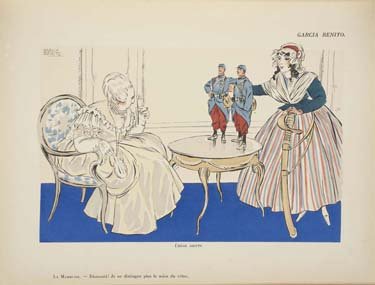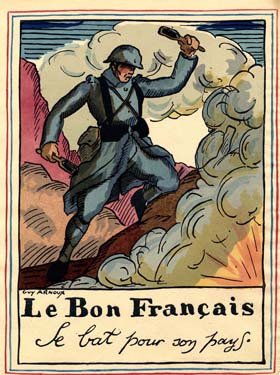Cultivating the Home Front
The war affected everyone in France. There were scarcities of food, fuel, and many commodities. Almost everyone knew or was related to one or more of the actual combatants. Official propagandists and illustrator commentators alike sought to sustain civilian morale during the deadly conflict. All those at home were a potential audience for every illustration.
Rare Book Collection, Gift of Neil Harris and Teri J. Edelstein
Published toward the beginning of the war, La Grand Guerre features the work of many artists, in approximately one hundred and fifty illustrations, in a variety of styles. Many are representational and range from battle scenes to allegories. Here, a marquise and her maid, the latter in the garb of the French Revolution, compare their two Zouave dolls and conclude they are just the same. Neither class nor politics is a barrier to the recognition of heroism. The Zouave troops also figure in another series of prints executed by Benito for Tolmer, also entitled La Grand Guerre: more than fifty color woodcuts of the events of 1915 in different theaters of the war.
Charles Genty. La baïonnette, 25 novembre 1915. Paris: L'Edition Française Illustrée
Rare Book Collection
Presumably many serving in the military enjoyed the barbed satire of La baïonnette but the primary audience for the magazine was those who remained on the home front. A number of issues dealt with their lives. "Les remplaçantes" put a spotlight on the substitutes, mostly women, for men away fighting for the cause. Charles Genty, a well-known humorous illustrator who served during the war also worked for such magazines as Le rire, Le rire rouge, and Fantasio and illustrated novels. Other issues of the magazine dealt with such subjects as "Nos gosses" (Our kids), "La vie chère" (The expensive life), and "Les nouveaux riches."
On loan from a private collection
Image permissions: Devambez; François-Jerome Arnoux, www.guyarnoux.fr
In a series probably published during the war as a spur to civilian support, the five protagonists all contribute in a significant way. Each page resembles one panel in a traditional story printed by Pellerin in Epinal. The farmer cultivates wheat, his scythe a weapon against the enemy. An elderly gentleman purchases national-defense bonds. Another exhorts a woman in a shop to make a purchase, to bolster the economy. A worker in a munitions plant stands heroically holding a shell ready for combat. Of course, all of these support the best of the French, the soldier, also depicted in the portfolio, who bravely defends their country.



